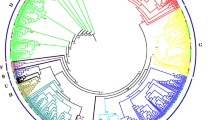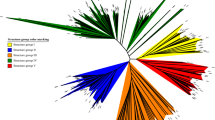Abstract
SBP-box genes are a class of plant-specific transcription factors which have a common DNA-binding domain (SBP-domain) with an unusual zinc-finger architecture. Many of the genes in this class are thought to play a developmental role and a few are involved in the determination of plant architecture. We have made a comparative study of these genes in the genomes of rice (Oryza sativa japonica and Oryza sativa indica) and its nine siblings using a recently proposed hybrid method for orthology and paralogy detection (HyPPO). According to HyPPO, the SBP-box proteins of rice siblings could be divided into twenty primary orthologous groups on the basis of their overall sequence features. This contrasts with a much less number of groups found in earlier work with other plant genomes using phylogenetic analysis of the SBP-domains only. The orthologous groups reported by HyPPO showed close correspondence in exon–intron structure and motif conservation. Comparison between different Oryza species revealed disparity in the maintenance of orthologous genes which may result in their different developmental characteristics. Inclusion of the SBP-box proteins from A. thaliana did not result in any change in the orthologous groups except for the A. thaliana proteins being added to some of the existing groups. The closer correspondence between the proteins in the primary orthologous clusters is expected to help in a more reliable prediction of their functions. It is also expected to provide better insight into the evolutionary history of this class of plant-specific proteins.






Similar content being viewed by others
References
Abdullah M, Cao Y, Cheng X, Shakoor A, Su X, Gao J and Cai Y 2018 Genome-wide analysis characterization and evolution of SBP genes in Fragaria vesca, Pyrus bretschneideri, Prunus persica and Prunus mume. Front. Genet. 9 64
Altenhoff AM, Studer RA, Robinson-Rechavi M, and Dessimoz C 2012 Resolving the ortholog conjecture: orthologs tend to be weakly, but significantly, more similar in function than paralogs. PLoS Comput. Biol. 8 e1002514
Altenhoff AM, Gil M, Gonnet GH and Dessimoz C 2013 Inferring hierarchical orthologous groups from orthologous gene pairs. PLoS One 8 https://doi.org/10.1371/journal.pone.0053786
Bailey PC, Dicks J, Wang TL and Martin C 2008 IT3F: a web-based tool for functional analysis of transcription factors in plants. Phytochemistry 69 2417–2425
Bhowmick P, and Guharoy M, Tompa P. 2015 Bioinformatics Approaches for Predicting Disordered Protein Motifs. Adv. Exp. Med. Biol. 870 291–318
Birkenbihl RP, Jach G, Saedler H, and Huijser P 2005 Functional dissection of the plant-specific SBP-domain: overlap of the DNA-binding and nuclear localization domains. J. Mol. Biol. 352 585–596
Brown CJ, Takayama S, Campen AM, Vise P, Marshall TW, Oldfield CJ, Williams CJ and Dunker AK 2002 Evolutionary rate heterogeneity in proteins with long disordered regions. J. Mol. Evol. 55 104–110
Chen X, Zhang Z, Liu D, Zhang K, Li A and Mao L 2010 SQUAMOSA promoter-binding protein-like transcription factors: star players for plant growth and development. J. Integr. Plant Biol. 52 946–951
Costantini S, Colonna G and Facchiano AM 2006 Amino acid propensities for secondary structures are influenced by the protein structural class. Biochem. Biophys. Res. Commun. 342 441–451
Crooks GE, Hon G, Chandonia JM and Brenner SE 2004. WebLogo: a sequence logo generator. Genome Res. 14 1188–1190
Davey NE, Haslam NJ, Shields DC and Edwards RJ 2011 SLiMSearch 2.0: biological context for short linear motifs in proteins. Nucleic Acids Res. 39 W56–W60
Finn RD, Bateman A, Clements J, Coggill P, Eberhardt RY, Eddy SR and Sonnhammer EL 2013 Pfam: the protein families database. Nucleic Acids Res. 42 D222–D230
Finn RD, Clements J and Eddy SR 2011 HMMER web server: interactive sequence similarity searching. Nucleic Acids Res. 39 W29–W37
Fitch WM 1970 Distinguishing homologous from analogous proteins. Syst. Zool. 19 99–113
Gabaldón T and Koonin EV 2013 Functional and evolutionary implications of gene orthology. Nat. Rev. Genet. 14 360–366
Gao K, Miller J 2020 Primary orthologs from local sequence context. BMC Bioinform. 21 48
Goodstein DM, Shu S, Howson R, Neupane R, Hayes RD, Fazo J and Rokhsar DS 2011 Phytozome: a comparative platform for green plant genomics. Nucleic Acids Res. 40 D1178–D1186
Garcia-Molina A, Xing S and Huijser P 2014 Functional characterisation of Arabidopsis SPL7 conserved protein domains suggests novel regulatory mechanisms in the Cu deficiency response. BMC Plant Biol. 14 231
Hammesfahr B, Odronitz F, Mühlhausen S, Waack S and Kollmar M 2013 GenePainter: a fast tool for aligning gene structures of eukaryotic protein families, visualizing the alignments and mapping gene structures onto protein structures. BMC Bioinformatics 14 77
Hou H, Li J, Gao M, Singer SD, Wang H, Mao L, Fei Z and Wang X 2013 Genomic organization, phylogenetic comparison and differential expression of the SBP-box family genes in grape. PLoS One 8 e59358
Itoh T, Tanaka T, Barrero RA, Yamasaki C, Fujii Y, Hilton PB and Bureau T 2007 Curated genome annotation of Oryza sativa ssp. japonica and comparative genome analysis with Arabidopsis thaliana. Genome Res. 17 175–183
Iwema T, Chaumot A, Studer RA, Robinson-Rechavi M, Billas IML, Moras D, Laudet V and Bonneton F 2009 Structural and evolutionary innovation of the heterodimerization interface between USP and the ecdysone receptor ECR in insects. Mol. Biol. Evol. 26 753–768
Jiao Y, Wang Y, Xue D, Wang J, Yan M, Liu G and Qian Q 2010 Regulation of OsSPL14 by OsmiR156 defines ideal plant architecture in rice. Na. Genet. 42 541
Jin J, Tian F, Yang DC, Meng YQ, Kong L, Luo J and Gao G 2016 PlantTFDB 4.0: toward a central hub for transcription factors and regulatory interactions in plants. Nucleic Acids Res. 45 D1040–D1045
Kawahara Y, de la Bastide M, Hamilton JP, Kanamori H, McCombie WR, et al. 2013 Improvement of the Oryza sativa Nipponbare reference genome using next generation sequence and optical map data. Rice 6 4
Koonin EV 2005 Orthologs, paralogs, and evolutionary genomics. Annu. Rev. Genet. 39 309–338
Kurata N and Yamazaki Y 2006 Oryzabase. An integrated biological and genome information database for rice. Plant Physiol. 140 12–17
Klein J, Saedler H and Huijser P 1996 A new family of DNA binding proteins includes putative transcriptional regulators of theAntirrhinum majus floral meristem identity gene SQUAMOSA. Mol. Gen. Genet. 250 7–16
Lafond M, Meghdari Miardan M and Sankoff D 2018 Accurate prediction of orthologs in the presence of divergence after duplication. Bioinformatics 34 i366–i375
Lee J, Park JJ, Kim SL, Yim J and An G 2007 Mutations in the rice liguleless gene result in a complete loss of the auricle, ligule and laminar joint. Plant Mol. Biol. 65 487–499
Li L, Stoeckert CJ and Roos DS 2003 OrthoMCL: identification of ortholog groups for eukaryotic genomes. Genome Res. 13 2178–2189
Li XY, Lin EP, Huang HH, Niu MY, Tong ZK, Zhang JH 2018 Molecular Characterization of SQUAMOSA PROMOTER BINDING PROTEIN-LIKE (SPL) Gene Family in Betula luminifera. Front. Plant Sci. 9 https://doi.org/10.3389/fpls.2018.00608
Miura K, Ikeda M, Matsubara A, Song XJ, Ito M, Asano K and Ashikari M 2010 OsSPL14 promotes panicle branching and higher grain productivity in rice. Nat. Genet. 2 545
Nehrt NL, Clark WT, Radivojac P and Hahn MW 2011 Testing the ortholog conjecture with comparative functional genomic data from mammals. PLoS Comput. Biol.7 https://doi.org/10.1371/journal.pcbi.1002073
Pace CN and Scholtz JM 1998 A helix propensity scale based on experimental studies of peptides and proteins. Biophys. J. 75 422–427
Riese M, Höhmann S, Saedler H, Münster T and Huijser P 2007 Comparative analysis of the SBP-box gene families in P. patens and seed plants. Gene 401 28–37
Roth AC, Gonnet GH and Dessimoz C 2008 Algorithm of OMA for large-scale orthology inference. BMC Bioinform. 9 518
Schultz J, Copley RR, Doerks T, Ponting CP and Bork P 2000 SMART: a web-based tool for the study of genetically mobile domains. Nucleic Acids Res. 28 231–234
Si L, Chen J, Huang X, Gong H, Luo J, Hou Q and Chen E 2016 OsSPL13 controls grain size in cultivated rice. Nat. Genet. 48 447
Studer RA and Robinson-Rechavi M 2009 How confident can we be that orthologs are similar, but paralogs differ? Trends Genet. 25 210–216
Sydykova DK, Jack BR, Spielman SJ and Wilke CO 2017 Measuring evolutionary rates of proteins in a structural context. F1000Res 6 1845
Train CM, Glover NM, Gonnet GH, Altenhoff AM and Dessimoz C 2017 Orthologous Matrix (OMA) algorithm 2.0: more robust to asymmetric evolutionary rates and more scalable hierarchical orthologous group inference. Bioinformatics 33 i75–i82
van der Lee R, Buljan M, Lang B, Weatheritt RJ, Daughdrill GW, et al. 2014 Classification of intrinsically disordered regions and proteins. Chem. Rev. 114 6589–6631
Van Roey K, Uyar B, Weatheritt RJ, Dinkel H, Seiler M, Budd A, Gibson TJ and Davey NE 2014 Short linear motifs: ubiquitous and functionally diverse protein interaction modules directing cell regulation. Chem. Rev. 114 6733–6778
Varadi M, Guharoy M, Zsolyomi F and Tompa P 2015 DisCons: a novel tool to quantify and classify evolutionary conservation of intrinsic protein disorder. BMC Bioinform. 16 https://doi.org/10.1186/s12859-015-0592-2
Voordeckers K, Pougach K and Verstrepen KJ 2015 How do regulatory networks evolve and expand throughout evolution? Curr. Opin. Biotechnol. 34 180–188
Wang L, Sun S, Jin J, Fu D, Yang X, Weng X and Zhang Q 2015 Coordinated regulation of vegetative and reproductive branching in rice. Proc. Nat. Acad. Sci. 112 15504–15509
Wang P, Chen D, Zheng Y, Jin S, Yang J and Ye N 2018 Identification and Expression Analyses of SBP-Box Genes Reveal Their Involvement in Abiotic Stress and Hormone Response in Tea Plant (Camellia sinensis). Int. J. Mol. Sci. 19 3404
Xie K, Wu C and Xiong L 2006 Genomic organization, differential expression and interaction of SQUAMOSA promoter-binding-like transcription factors and microRNA156 in rice. Plant Physiol. 142 280–293
Xu M, Hu T, Zhao J, Park MY, Earley KW, Wu G and Poethig RS 2016 Developmental functions of miR156-regulated SQUAMOSA PROMOTER BINDING PROTEIN-LIKE (SPL) genes in Arabidopsis thaliana. PLoS Genet. 12 e1006263 https://doi.org/10.1371/journal.pgen.1006263
Yamasaki K, Kigawa T, Inoue M, Tateno M, Yamasaki T, et al. 2004 A novel zinc-binding motif revealed by solution structures of DNA-binding domains of Arabidopsis SBP-family transcription factors. J. Mol. Biol. 337 49–63
Yamasaki K, Kigawa T, Inoue M, Yamasaki T, Yabuki T, Aoki M and Shirouzu M 2006 An Arabidopsis SBP-domain fragment with a disrupted C-terminal zinc-binding site retains its tertiary structure. FEBS Lett. 580 2109–2116
Yang Z, Wang X, Gu S, Hu Z, Xu H and Xu C 2008 Comparative study of SBP-box gene family in Arabidopsis and rice. Gene 407 1–11
Zhong H, Kong W, Gong Z, Fang X, Liu C and Li Y 2019 Evolutionary analyses reveals diverged patterns of SQUAMOSA promoter binding protein-like (SPL) gene families in Oryza genus. Front. Plant 10 565
Acknowledgements
PRA acknowledges the support from the funding agency DST/INSPIRE (DST/Inspire Fellowship 2015/IF150448; dated: 24/08/2015). The authors extend their thanks to Dr. Manuel Lafond for his technical assistance and guidance. PRA also acknowledges Dr. Ananyo Chowdhury for the initial problem in this study and Dr. Saikat Dutta Chowdhury for his technical assistance and guidance.
Author information
Authors and Affiliations
Corresponding author
Additional information
Corresponding editor: BJ Rao
Electronic supplementary material
Below is the link to the electronic supplementary material.
Rights and permissions
About this article
Cite this article
Agarwal, P.R., Lahiri, A. Comparative study of the SBP-box gene family in rice siblings. J Biosci 45, 83 (2020). https://doi.org/10.1007/s12038-020-00048-z
Received:
Accepted:
Published:
DOI: https://doi.org/10.1007/s12038-020-00048-z




